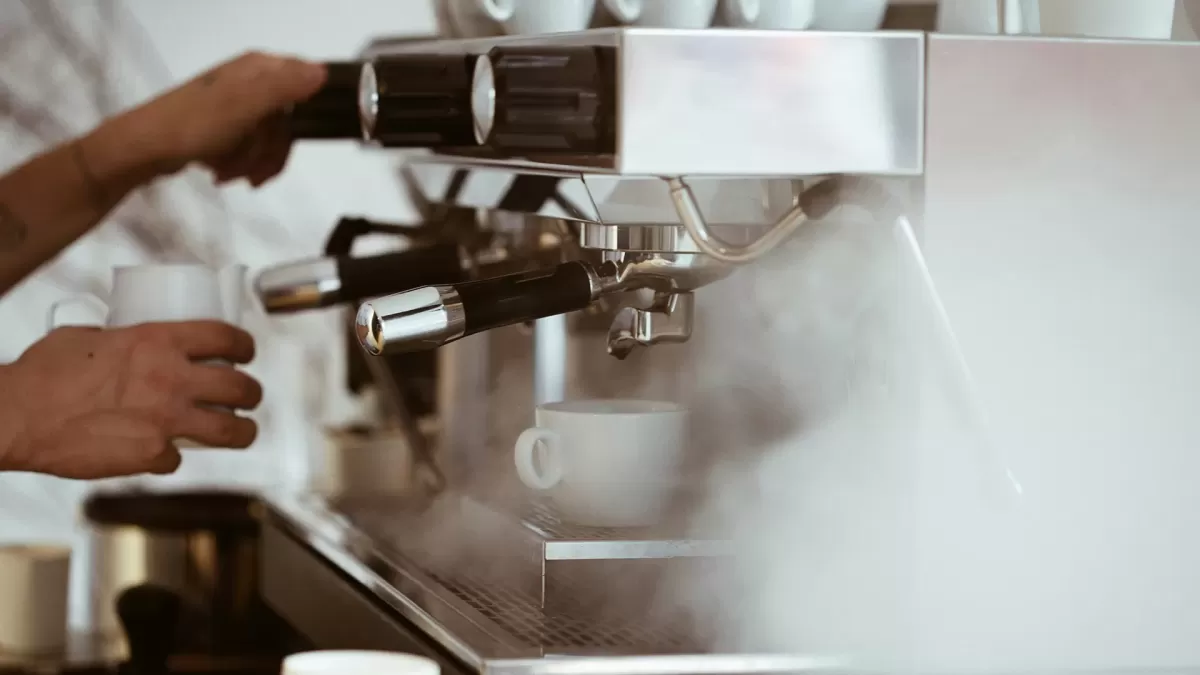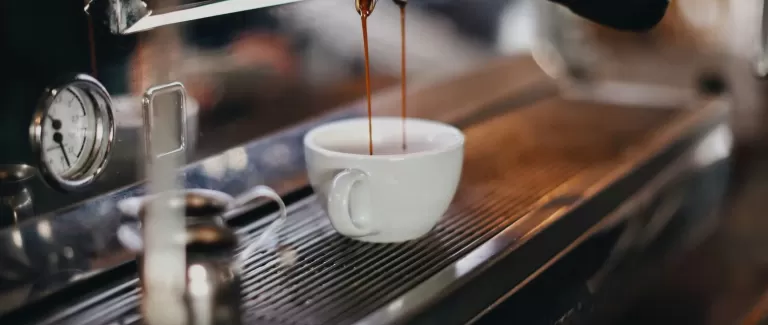Coffee machines, whether traditional or bean-to-cup, all follow a similar fundamental process: water is heated and pushed through coffee grounds to create a rich, flavorful espresso. Whether you’re crafting specialty drinks for customers or providing employees with barista-level coffee, the right coffee machine can transform the experience.
Let’s delve into how coffee machines function, the components that make them tick, and how you can master the art of espresso creation.
Coffee Machine Types
There are many types of coffee machines available, from manual and semi-automatic models for artisan control to fully automatic, pod, and bean-to-cup machines designed for convenience and efficiency in offices or busy environments. However, this article focuses on the mechanics of a standard barista espresso machine, the go-to choice for crafting high-quality espresso with precision.
What is an Espresso Machine?
An espresso machine is a specialised device designed to brew espresso, a concentrated coffee shot extracted by forcing hot water under pressure through finely-ground coffee. Its precision engineering ensures optimal temperature, pressure, and extraction time—factors that are critical for delivering the bold flavours and creamy crema unique to espresso.

How Does an Espresso Machine Work?
Espresso machines are marvels of engineering, designed to turn water and finely-ground coffee into the perfect shot of espresso. By understanding the step-by-step process and the critical components involved, you’ll gain insight into how these machines consistently deliver exceptional coffee. Here’s a breakdown of how it all comes together:
The Brewing Process and Key Components
1. Water Supply
The process begins with water, sourced either from a built-in reservoir or directly from a plumbing connection. The reservoir stores fresh water, essential for maintaining the quality of the coffee and preventing mineral buildup inside the machine.
2. Heating in the Boiler
Once the water enters the system, it is transferred to the boiler. This critical component heats the water to the optimal brewing temperature, typically between 90–96°C. Maintaining this precise range is crucial for extracting the coffee’s full flavour profile without over-extraction (bitterness) or under-extraction (sourness).
High-end espresso machines often feature dual boilers, with one dedicated to brewing and the other to steaming milk. This allows baristas to prepare espresso and froth milk simultaneously, an essential capability for busy settings.
3. Pressure Generation in the Pump
Next, the pump activates, creating the pressure required for brewing. Espresso machines are calibrated to generate approximately 9 bars of pressure—about nine times the atmospheric pressure at sea level. This immense force pushes hot water evenly through the coffee grounds in the portafilter, extracting rich oils, aromas, and flavours that define a well-balanced espresso shot.
Two common types of pumps are used:
- Vibration pumps, ideal for smaller machines.
- Rotary pumps, often found in commercial-grade models for their durability and quiet operation.
4. Coffee Extraction Through the Group Head and Portafilter
The heated, pressurised water flows through the group head, a temperature-controlled interface where the brewing magic happens. The group head evenly distributes water over the coffee puck held in the portafilter—a sturdy handle with a metal basket that holds the finely-ground coffee.
Baristas tamp the coffee grounds into a compact “puck” to create a uniform surface, ensuring the water flows evenly for consistent extraction. The portafilter locks tightly into the group head, creating a sealed system that directs all water through the coffee grounds. This stage produces the rich, concentrated espresso shot topped with a signature crema.
5. Milk Frothing with the Steam Wand (Optional)
For milk-based drinks like lattes and cappuccinos, the steam wand becomes the star. It uses pressurised steam from the boiler to froth milk, creating the desired texture:
- Silky microfoam for lattes and flat whites.
- Thicker, airy foam for cappuccinos.
Skilled baristas can control the angle, depth, and steam flow to achieve the perfect milk texture and even craft intricate latte art.
6. Dispensing and Cleanup
Once brewing is complete, the espresso is dispensed into a cup, ready to be served as is or combined with milk for specialty drinks. The spent coffee grounds are removed from the portafilter and discarded into a knock box.
Key components like the drip tray collect excess water and spills, while regular cleaning of the group head, portafilter, and steam wand ensures optimal machine performance and hygiene. Machines with advanced features may also include self-cleaning systems to streamline maintenance.

The Science Behind the Perfect Espresso
While a coffee machine does much of the heavy lifting, crafting the perfect espresso still requires skill and attention to detail. Several variables influence the final result, and mastering them is essential for coffee shop owners and office managers who want top-quality coffee.
Making a perfect espresso involves balancing key variables:
- Grind Size: Espresso requires a fine grind for proper extraction.
- Tamping Pressure: Compacting the coffee grounds evenly ensures uniform water flow.
- Water Temperature: Too hot or too cold, and the coffee’s flavours can be compromised.
- Extraction Time: A standard shot takes 25–30 seconds for optimal flavour.
- Coffee-to-Water Ratio: Typically 1:2 (e.g., 18 grams of coffee for 36 grams of espresso).
Mastering these factors, along with using a well-maintained espresso machine, ensures consistently great espresso.
Why Invest in a High-Quality Espresso Machine?
- Maintain precise temperatures and pressures for consistent results.
- Handle high-volume usage without compromising quality.
- Offer programmable settings for tailored brewing.
- Enhance the coffee experience, whether in a café or an office environment.
The benefits of a premium coffee machine go beyond just the mechanics. For coffee shop owners, a high-quality machine ensures consistency, a critical factor in building customer trust and loyalty. For office environments, a reliable machine contributes to employee satisfaction and productivity, showing that the business values their well-being.
Choosing the Right Coffee Machine for Your Business
If you’re unsure where to start, The Office Coffee Company offers a range of machines tailored to your needs. From advanced bean-to-cup systems ideal for offices to semi-automatic machines perfect for coffee shops, our solutions prioritise quality, ease of use, and reliability.
Our team of experts can guide you through the decision-making process, ensuring you choose a machine that aligns with your business goals. Explore our range of coffee machines at The Office Coffee Company or contact us for personalised recommendations.



